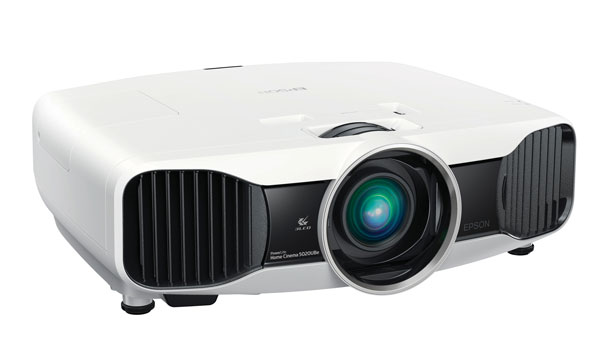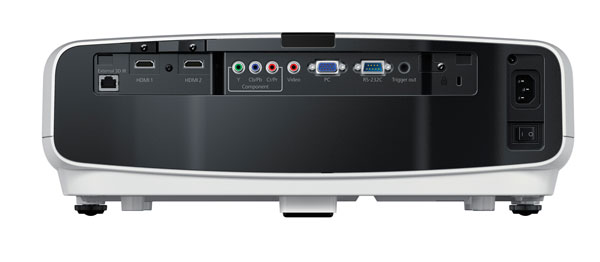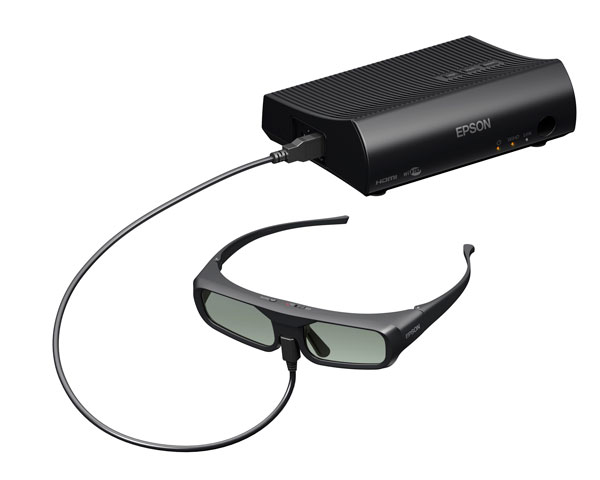
When it comes to high performance, high value home theater projectors, Epson has a proven track record that's tough to beat. The last model of theirs I reviewed was the impressive 8500UB - a machine I was loath to hand over to the UPS man when it was time to say goodbye. This time out, I was able to spend some quality time with the ultra bright 5020UBe. Although 5020 is a smaller number than 8500, don't let that fool you. Things have only gotten better with time. If you're in the market for a 3D-capable LCD projector, you'll want to read on. (And if you're like me and you couldn't care less about 3D, read on anyway.)
It should be noted that the 5020UBe is the nearly-identical twin of Epson's 5020UB. The one difference is that the 5020UBe includes Epson's WirelessHD technology, a $300 feature which allows you to beam your HDMI source signal(s) wirelessly using an external transmitter. We'll talk more about WirelessHD in a minute, but apart from this feature, the 5020UB and 5020UBe are otherwise the same projector. Epson was kind enough to send me a 5020UBe, so I'll make reference to both models throughout this review. Just remember that with the exception of anything related to WirelessHD, all comments apply equally to both models.

Placement Flexibility
Like most front projectors, the 5020UBe features dual HDMI inputs along with a few other connection options - composite, S-video, and component video - which you're increasingly less apt to use. A VGA input is also available for connection to a PC. I connected my Oppo 2D Blu-ray Disc player via HDMI in two different ways. First, I made a traditional connection via my Onkyo A/V Receiver (HDMI from player into receiver and out to projector). Next, I made a wireless connection utilizing Epson's WirelessHD technology.
The 5020UBe is priced $300 higher than the 5020UB on account of its WirelessHD feature. This gets you an external transmitter which you'll need to locate near your source equipment - provided it's within roughly 30 feet of the projector. The transmitter features a whopping five HDMI inputs, a single HDMI output, an optical audio output, and a USB port for charging the 3D glasses, which are included with the projector. In my A/B comparisons, I wasn't able to detect any picture degradation or time lag issues when using the WirelessHD connection, so it really is just a convenient alternative if you're looking to run fewer wires to your projector. Whether or not that's worth $300 is up to you.
The WilrelessHD feature can certainly be handy for an outdoor theater set-up as you'll have less gear (or fewer wires) exposed to the elements. We should mention that the 5020UB/5020UBe) is not really rated (nor intended) for outdoor use.
Consumers who spring for the 5020UBe will enjoy greater installation flexibility thanks to its WirelessHD capability, but the standard 5020UB is no slouch in this department. Epson gives the 5020UB best-in-class horizontal and vertical lens shift versatility and a generous 2.1:1 zoom ratio. In my basement theater/equipment test lab, I have a custom-built soffit designed to hide a beam and conceal my projector.Thanks to the 5020UB's extreme vertical lens shift, I was able to ceiling mount the projector right-side-up - something you can't do with many projectors. For anyone with a similar setup, this should be welcome news.
Wow, That's Bright
One of the first things you'll notice about the 5020UBe is its intense brightness - we're talking light cannon. Although you'd probably never want to use all the lumens this thing can put out (2400 to be exact), it's nice to know they're there. Just as you can always cut your hair shorter (but not longer) during a haircut, you can always change the color mode and dial things back if you smell your retinas burning. However, if you don't have the light output to begin with, you're out of luck. Thankfully, the 5020UBe has light output to spare. Anyone who enjoys having a few lights on or leaving the curtains open while watching a movie will definitely want to give a long, hard look at the 5020UBe.
I used the "THX" color mode as my baseline, which looked great out of the box and required little tuning to get things looking even better. You can also choose from others such as "Cinema," "Living Room" (for daytime viewing), and "Dynamic" (for maximum brightness). Fortunately (and unfortunately), 3D viewing invokes an entirely separate set of color modes including "3D Dynamic," "3D Cinema," and "THX 3D." Since you're wearing tinted glasses, 3D viewing always benefits from extra brightness, so 3D Dynamic and 3D Cinema seemed preferable to THX 3D, which was entirely too dark for my tastes. Then again, like everything else pertaining to 3D, preferred image brightness is highly subjective and your mileage may vary.

Remote, Control
Epson includes a large, fully-backlit remote control with the 5020UBe. On it you'll find dedicated buttons for each source input plus a few handy shortcut buttons. The "2D/3D" button quickly turns off 3D viewing. "Super-res" adjusts Super Resolution settings (more on that in a minute). "Color Mode" toggles between the aforementioned image presets. The 5020UBe remote also features a handful of buttons reserved for WirelessHD viewing and source switching.
The 5020UBe features a plain but intuitive on-screen display with basic and advanced settings never more than a few clicks away. Custom video settings can be saved to ten different memory locations making it easy to create unique settings for each of your source devices. In addition to basic video settings, the "Image" menu is also home to the Auto Iris setting. Unfortunately, the 5020UBe does require the use of an auto iris to achieve its deepest blacks, so that means you'll hear it operate if the projector is near your seating position. You'll also notice the overall brightness change - a mildly irritating effect which may lead some viewers to disable the auto iris entirely. The good news is that even with the iris disabled, blacks still look pretty darn great.
Epson claims a lamp life of 4,000 hours when using the 5020UBe in "Normal" mode. You can prolong that further, and use less power in the process, by changing the Power Consumption mode to "Eco." You'll lose some light output in "Eco" mode, but if you're in a darkened room, rest assured you won't miss it one bit. I ran my test unit in "Eco" mode paired with the "THX" color mode, and still had a to tone things down further during calibration. Did I mention this thing is bright?

Picture Time
Out of the box, Epson's "THX" color mode provides excellent color accuracy and solid grayscale tracking. Necessary adjustments were relatively minor and most of my calibration time was spent refining as opposed to fixing the 5020UB's stock picture. As with any front projector of this caliber (read "price"), I always recommend a professional calibration. Epson's stock image is excellent in both the "THX" and "Cinema" color modes, but if you're going to spend this kind of money on your display device, you might as well get the most out of it. If it were me, I'd skip the WirelessHD option and spend that money instead on a professional ISF or THX calibration. Check the ISF web site for a calibrator near you.
Video processing and film cadence detection on the 5020UBe are quite good, with test clips from the Gladiator DVD, I Am Legend Blu-ray Disc, and my HQV Benchmark discs presenting no real challenges to speak of. One thing I did note is that my Gladiator DVD, with its challenging portrayal of diagonal lines in the Rome flyover sequence, looked a bit better than it usually does. This is thanks in part to Epson's Super Resolution feature, a detail enhancement algorithm which manages to make standard definition content appear sharper without adding much in the way of artifacts - on the lower settings at least. The higher values did add some noise, so I left it on "2" for most of my time and was pleased with the slight improvement it lent to DVD and Netflix SD viewing.
It's somewhat ironic that a projector this bright has such remarkably deep blacks (not that I'm complaining). I have Carada's awesome Masquerade masking system on my 92-inch diagonal screen. This allows me to adjust the black mask around the edges of the screen to move in or out to suit the aspect ratio of the program material. Watching a 2.35:1 CinemaScope movie, I can move the top and bottom of the frame in to enhance the darkness of the frame (thereby enhancing the perceived brightness of the image). But the 5020UBe's representation of the black bars was black enough that if the Masquerade's remote control was out of reach, I often didn't bother. (Granted, I may be lazy, but I'm also a stickler when it comes to those pesky black bars!)
For this pricetag, I don't know of any other projectors capable of producing blacks this deep while painting the image with such a natural and accurate color palette. JVC's D-ILA projectors are probably the only ones that come to mind, but you'll need to spend some extra money to get there and don't expect one of those to match the brightness levels of the Epson.
I fed the 5020UBe a wide variety of 2D and 3D content from both my DISH Hopper HD DVR and two different Blu-ray Disc players (Oppo 2D and Sony 3D) and everything I watched looked better than the last. From Harrison Ford's sharply-rendered stubble in Raiders of the Lost Ark (Paramount Blu-ray) to the wonderful shadow detail on display during the Chernobyl sequence of It's a Good Day to Die Hard (Dish 1080p on-demand), the 5020UBe produced an utterly gorgeous picture time after time. Unfortunately, it could do nothing to improve the script in that newest Die Hard - blech.
Like many display devices these days, the 5020UB features a frame interpolation mode designed to smooth out and improve the clarity of fast-moving images. Anyone who enjoys the natural cadence of film will want to turn this off and leave it off, but thankfully the lowest setting is sufficiently subtle for those who appreciate the feature. Epson was also kind enough to put a dedicated button on the remote for direct access to this control.

3D? Check.
The 5020UBe includes two pairs of active shutter RF glasses for 3D viewing. Provided you stay within 32 feet of the projector, they should work wherever you are in the room and that proved true in my basement theater. I did have some trouble getting them to pair, but I think this is due to the fact that the glasses turn off if not paired successfully - a fact that's stated in the 3D glasses' instruction booklet which I missed during my initial read-through. Once I paired the glasses successfully, I was able to re-pair them several more times without a problem.
As I've stated many times before, I'm hardly 3D's biggest fan. However, I've seen enough 3D to tell the good from the bad (or the bad from the worse, as is sometimes the case) and the 5020UBe does an admirable job with its presentation of 3D content. When 3D content is detected, the projector automatically switches to its last-used 3D color mode and you can easily switch back to 2D using the 2D/3D button on the remote. I played both Paramount's Thor 3D and Disney's Ghosts of the Abyss 3D and both titles presented a pleasant 3D image with minimal visible crosstalk.
Epson's included glasses are relatively lightweight, comfortable, and they easily fit over regular eyeglasses, but additional sets of glasses are a bit pricey. However, with Epson adhering to the new RF 3D glasses standards, you should be able to use other less expensive RF-based 3D glasses (such as these ones made by Samsung) with this projector to good effect.
Turn Ons
Turn Offs
Final Thoughts
With its deep black levels, accurate colors, dependable grayscale tracking, and intense light output, the 5020UB has it where it counts in every department. Regardless of whether or not you plan to make use of its 3D capabilities, if I were shopping for a sub-$3,000 home theater projector, the 5020UB is where I'd start (and stop) looking. Highly recommended.
Specifications from the Manufacturer:
Where to Buy:
Manufacturer's Contact Information:
Epson America, Inc.
3840 Kilroy Airport Way
Long Beach, CA, USA 90806
Telephone: 1-562-981-3840
Fax: 1-562-290-522
On the Web: www.epson.com
| Overall | |
|---|---|
| Value | |
| Performance | |
| Features/Ergonomics |